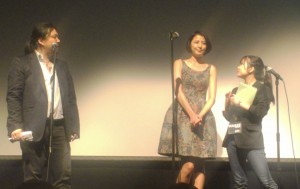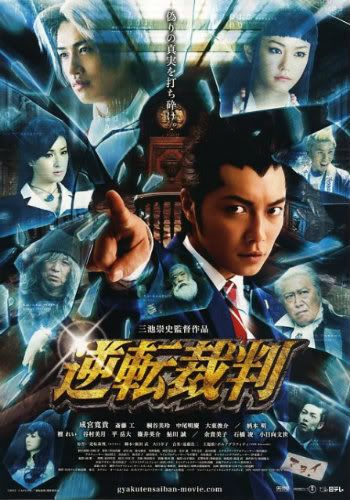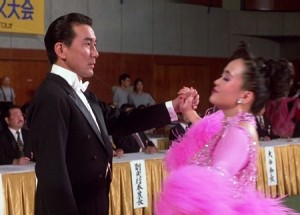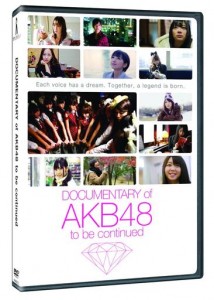JQ Magazine: Film Review – ‘Love Strikes!’ Twice at JAPAN CUTS Film Festival

‘Love Strikes!’ star Masami Nagasawa, center, with JAPAN CUTS festival curator Samuel Jamier at Japan Society, July 14, 2012. (Shinobu Torii)
By Rick Ambrosio (Ibaraki-ken, 2006-08) for JQ magazine. Rick manages the JET Alumni Association of New York (JETAANY)’s Twitter page and is the creator of the JETwit column Tadaima!
Love Strikes! had its encore screening July 22 at Japan Society’s annual JAPAN CUTS film festival, and I can tell why they had to run it a second time: a main character with a wide range, beautiful girls, and the hilarious situations he gets himself into with them (though the funny stuff is a little frontloaded, but we’ll get to that).
Hitoshi Ohne’s Love Strikes! (or Moteki 「モ テキ」) is based on a manga of the same name and is the sequel to the popular television series. The main character, Yukiyo Fujimoto (Mirai Moriyama) is a young man entering middle age and finding his luck with women wanting. From out of nowhere, he has his moteki, or time of great popularity with women of the opposite sex, which is said to happen to a man just three times in his life.
The movie’s events find us after his first moteki, with Yukiyo wishing for another shot with a great girl. That great girl’s name is Miyuki (Masami Nagasawa), whom Yukiyo makes a connection with over Twitter. We then see our introspective thirty-something hero chasing her all over Japan, making laughs, breaking hearts, and learning through the whole process.
Jen Wang (Miyagi, 2008-09) is a lab tech in Dallas and a staff writer for the Japanese music website Purple SKY. Her love of cosplay and her junior high school students inspired the name for her own Japanese pop culture blog, Hibari-sensei’s Classroom.
Ace Attorney (known as Gyakuten Saiban in Japan) made its Texas debut at the 2012 Asian Film Festival of Dallas. Unlike most of my fellow audience members at the sold-out closing night screening, I was neither a fan of the Phoenix Wright video games nor a fan of director Takashi Miike. I was, however, curious about the franchise that spawned hoards of cosplayers shouting “Objection!” across a con floor and a huge fan of the movie’s two stars: Hiroki Narimiya and Takumi Saito. The trailer promised an intense, over-the-top courtroom drama. What I didn’t expect was to be laughing for the majority of the film as well.
Ace Attorney takes place in the “near future”, in which people have anime hair and punny names and courtrooms employ Stark Industries holographic technology. Court cases must be settled in three days in a reality TV-like format. Phoenix Wright (Narimiya) is a rookie defense attorney who after nearly choking on his first trial, finds himself entangled in two big cases. The first deals with the murder of his mentor Mia Fey (Rei Dan) and the wrongful accusal of her sister Maya (Mirei Kiritani). Wright battles—and that is the best term to describe the courtroom showdown—Miles Edgeworth (Saitoh), a prosecutor whose ruthless tactics have won him admiration but not a lot of allies. Edgeworth is later framed for murder, and Wright has to not only solve the mystery but face the undefeated Manfred von Karma (Ryo Ishibashi).

To read the rest of the review, click here.
Justin’s Japan: Week Three of JAPAN CUTS 2012 Blasts Off with ‘Space Battleship Yamato’ Premiere
http://www.youtube.com/watch?v=Row0rYFQCHs
By JQ magazine editor Justin Tedaldi (CIR Kobe-shi, 2001-02) for Examiner.com. Visit his Japanese culture page here for related stories.
Japan Society’s annual JAPAN CUTS festival winds down this week with a sensational lineup of cinema and stars. The DON’T STOP! JAPAN CUTS Party follows the July 26 screening of Don’t Stop!, featuring an introduction with director Kenji Kohashi.and Leonie director Hisako Matsui for the July 27 screening introduction and Q&A.
DON’T STOP! documents the journey of “CAP,” a hard-as-nails 46-year-old man who realizes his lifelong dream, to go to America and ride a Harley down Route 66. CAP’s love affair with America and motorcycles began when he was young, but when he was 26, a traffic accident immobilized his left hand and lower body. Over the next 20 years, much of his life has been spent either in bed or in a wheelchair. In a 10-day, 4200 km trip across the U.S., encounters and miracles happen along the way to breathe fresh life into CAP and his friends.
Other highlights include Toshiaki Toyoda’s enigmatic terrorist art house gem Monsters Club (July 25); tthe world premiere of moral shocker Ushijima the Loan Shark (July 25), which features the impressive film debut of AKB48’s Yuko Oshima (recipient of the festival’s first-ever Cut Above Award for Outstanding Debut); Hisako Matsui’s haunting docudrama Leonie (July 27); and climaxes with the North American premiere of one of the highest-grossing Japanese films of all time, Space Battleship Yamato (July 28).
For this week’s list of films, click here.
WIT Life #209: The Amazing Yakusho Koji!
WIT Life is a periodic series written by professional Writer/Interpreter/Translator Stacy Smith (Kumamoto-ken CIR, 2000-03). She starts her day by watching Fujisankei’s newscast in Japanese, and here she shares some of the interesting tidbits and trends together with her own observations.
I had an unusually exciting Friday night as I got to meet one of my favorite actors, Yakusho Koji! He was on hand at Japan Society’s wonderful 2-week film festival Japan Cuts to screen his movie The Woodsman and the Rain. He was also presented with the first ever Japan Cuts prize, the CUT ABOVE award for excellence in film. He is pictured here with festival coordinator Samuel Jamier and interpreter Linda Hoaglund during the pre-screening introduction, during which time he humbly thanked the audience for Read More
WIT Life #208: Monsters, Woodsmen and Girls, Oh My!
*************************************************************************************
WIT Life is a periodic series written by professional Writer/Interpreter/Translator Stacy Smith (Kumamoto-ken CIR, 2000-03). She starts her day by watching Fujisankei’s newscast in Japanese, and here she shares some of the interesting tidbits and trends together with her own observations.
It is indeed time again for one of my favorite annual events, Japan Cuts at Japan Society! The lineup of 39 films is more robust than ever, and the focus on fabulous actor Koji Yakusho adds a new dimension to this year’s festival. He will be on hand this Friday night to screen his 2011 award-winning The Woodsman and the Rain, and he will receive the first ever Japan Cuts prize, the CUT ABOVE award for excellence in film. Can’t wait for the screening and to possibly catch an up-close glimpse of this living legend at the reception after.
This event kicked off last Thursday, and many wonderful pieces have already been shown. I haven’t been able to catch as many as I would have liked, but one that really struck me was Read More
Justin’s Japan: Week Two of JAPAN CUTS 2012 Spotlights Late Film Legend Yoshio Harada

‘Shall We Dance?’ returns to the big screen July 21 as part of this week’s JAPAN CUTS offerings at New York’s Japan Society. (Daiei Co., Ltd )
By JQ magazine editor Justin Tedaldi (CIR Kobe-shi, 2001-02) for Examiner.com. Visit his Japanese culture page here for related stories.
This week, Japan Society’s annual JAPAN CUTS film festival pays tribute to the late actor Yoshio Harada, screening his final film Someday and 9 Souls, (both July 19). The festival also highlights the career of living legend Koji Yakusho, presenting five of his most inconic films over July 20-21: Chronicle of My Mother, Cure, Shall We Dance?, Toad’s Oil (which Yakusho also directed), 13 Assassins, and The Woodsman and the Rain.
Yakusho will be on hand for the Woodsman’s sold-out July 20 screening for an introduction, Q&A and reception. On that occasion, the festival will award the star the first ever JAPAN CUTS prize, the Cut Above Award for Excellence in Film. Yakusho will also appear for the July 21 screening of Takashi Miike’s hit samurai action movie 13 Assassins. Other highlights include Toshi Fujiwara’s provocative and poetic documentary on post-tsunami Japan No Man’s Zone (July 22, includes an introduction and Q&A with director Toshi Fujiwara).
Also, fans can enjoy encore screening of the irresistible blockbuster love comedy Love Strikes! (July 22). The film’s debut on July 17 welcomed a very special guest, Japanese Academy Award-winning actress Masami Nagasawa, who appeared following a live taiko performance by the legendary group Cobu.
For this week’s list of films, click here.
Justin’s Japan: Week One of JAPAN CUTS 2012 Serves Up ‘Love Strikes!’, Adult Anime

‘Love Strikes!’ has its U.S. premiere at New York’s Japan Society July 14. (© 2011 TOHO CO.,LTD. / TV TOKYO CORPORATION / DENTSU INC. / KODANSHA Ltd. / Sony Music Entertainment (Japan) Inc. / Office Crescendo Inc. / PARCO CO., LTD. / Yahoo Japan Corporation / TV OSAKA CORPORATION / TV AICHI CORPORATION)
By JQ magazine editor Justin Tedaldi (CIR Kobe-shi, 2001-02) for Examiner.com. Visit his Japanese culture page here for related stories.
From July 12-28, Japan Society ushers in its sixth consecutive year of JAPAN CUTS: The New York Festival of Contemporary Japanese Cinema. Bigger than ever, JAPAN CUTS 2012 boasts the most feature films in the festival’s history: 37 full-length and 2 shorts, encompassing blockbusters, high-concept art house titles, mature anime, audacious documentaries, delirious rom-coms and a splatter of J-horror/gore genre busters. Running alongside the New York Asian Film Festival (June 29-July 15), which co-presents 12 films from July 12-15, JAPAN CUTS 2012’s selections sport the unyielding artistry and out-of-control eccentricity that define modern Japanese cinema.
“This year’s expanded and expansive edition of JAPAN CUTS reflects our (slightly maniacal) ambition to be the ultimate platform for Japanese cinema in North America—in the world perhaps?” says Japan Society’s chief film programmer and festival curator Samuel Jamier. “In this respect, the explosive, purposefully off-balance mix of dark-themed hard-core actioners, blockbusters, hit comedies, nano-budget indie titles and philosophical art house pieces emphasizes the wild diversity of the production in the archipelago, as well as its incredible resilience, despite the rise of its East Asian neighbors and the current severe economic conditions. We might not be solving the epistemological conundrum that is Japanese and world cinema (or event zombie apocalypse), but we’re giving it a good try.”
Upcoming events include the sold out Striking Love! JAPAN CUTS Opening Party following the July 14 screening of Love Strikes!, with an introduction and Q&A with star actress Masami Nagasawa (this year’s recipient of NYAFF’s Rising Star Asia Award) and an introduction and Q&A with Monsters Club director Toshiaki Toyoda for the July 15 screening.
For this week’s list of films, click here.
JQ Magazine: JQ&A with Darryl Wharton-Rigby on ‘Don Doko Don: The Yamakiya Taiko Drum Club Project’

“This story is about the resiliency of community; how a community comes together in times of crisis. It’s a story about our shared human experience. It’s in some ways my own story, as my family still lives in Fukushima as well.”
By Nichole L. Knight (Shiga-ken, 2007-09) for JQ magazine. Originally from Waterbury, Connecticut, Nichole became active with the JET Alumni Association of New York even before moving to the city. Since returning from Japan, she’s played with the University of Connecticut Taiko Team, and trained with Soh Daiko, the East Coast’s oldest taiko group.
Darryl Wharton-Rigby (Fukushima-ken, 2005-07) is a playwright, poet, professor and filmmaker, who hails from Baltimore, Maryland. He has written for NBC, MTV, and BET. He lectures for Morgan State University’s Screenwriting and Animation Program, and is in the process of writing three books. Married with three children, he splits his time between Baltimore, Los Angeles, and Japan.
From 2005 to 2007, while teaching English in Kawamata-machi in Fukushima Prefecture through the JET Program, Wharton-Rigby was introduced to the talented members of the Yamakiya Taiko Club, a local community group which he would soon join. He began filming their story in 2006, but was inspired to continue after the group was misplaced in the aftermath of the 2011 tsunami and ensuing Fukushima Dai-Ichi Nuclear Power Plant area evacuations.
Of the documentary, now titled Don Doko Don: The Yamakiya Taiko Drum Club Project, Wharton-Rigby says, “…[T]his very well may be my most ambitious project. I never imagined my journey would bring me to [a] project with such an international scope and [is] profoundly personal on so many levels.” As the film’s writer, director and producer, he has unveiled an ambitious Kickstarter campaign to fund the project that closes July 11. In this exclusive interview, JQ caught up with Wharton-Rigby to discuss the origins of the film, the significance of Yamakiya on its devastated community, and the troupe’s international highlights so far.
Tell us a little about the Yamakiya Taiko Club and how you first came to know about it.
When I was a JET in Kawamata, I had to go to the Yamakiya District high in the mountains to teach at the elementary, junior high, and kindergarten schools. I met Megumi Endo, who was a school worker and head of the group at Yamakiya Elementary School. She invited me to play taiko drums with the Yamakiya Taiko Club and I was hooked. I loved the sound and power of the drums. There are three teams: Kodama, the beginning students; Suzaku, the intermediate students; and Yamazaru, the experienced members. I practiced with the younger members of Kodoma.
What inspired you to start making a documentary about them?
I started shooting footage of the group after breaking my finger. I couldn’t play the drums, but I still wanted to remain connected to the group. My background prior to JET was in film, so, I pulled out my camera and started shooting footage of the group. I would shoot rehearsals, performances, meetings, and on bus trips. I even followed around Genki Endo, who is the leader of the group. Megumi-san mentioned that it would be great to have a documentary about the group. I agreed. She came up with the title Don Doko Don—it’s the basic sound of the taiko beat. Over the years, I had compiled more than 80 hours of footage and when I would return to Japan, I would make sure to visit Yamakiya and I would bring along my camera and shoot more footage.
Why is it important to share this story with the world?
When I learned that Yamakiya was going to be evacuated because of high levels of radiation after the events of March 11, 2011, it broke my heart. I could not fathom this was really happening to a community and people I adored. Then I found out that despite the circumstances, the group was still practicing and performing together. I knew there was a story to be told. This story is about the resiliency of community; how a community comes together in times of crisis. It’s a story about our shared human experience. It’s in some ways my own story, as my family still lives in Fukushima as well.
JapanLocal: Tokyo Moves Video
Patrick Lee (also known as Pat Leezy) is a current 2nd year JET in Nagasaki-ken who specializes in videography. His videos can be seen on his Youtube Channel. He can be contacted through Facebook and Twitter.
Tokyo is a city of contrasts. Its towering skyscrapers and neon-lit nights suggest a modern metropolis ceaselessly advancing into its future. Yet Japan’s capital visibly prides itself on its rich heritage, preserving various historical landmarks throughout the city. Pat spent a week this past April during cherry blossom week exploring this delicate relationship with his point-and-shoot camera.
WIT LIfe #202: I Wish (奇跡)
WIT Life is a periodic series written by professional Writer/Interpreter/Translator Stacy Smith (Kumamoto-ken CIR, 2000-03). She starts her day by watching Fujisankei’s newscast in Japanese, and here she shares some of the interesting tidbits and trends together with her own observations.
Over the weekend I finally got to see I Wish (奇跡), the newest English release from my favorite Japanese director, Hirokazu Kore-eda (是枝裕和). This movie is set in Kyushu, and tells the story of two brothers separated due to their parents’ divorce (one up north in Fukuoka, one down south in Kagoshima). Now that all of Kyushu is connected by bullet train, the older brother had heard it said that if you are there at the moment when two shinkansen cross (in Kumamoto, where I was a JET), you can make a wish and it will come true.
The brothers (the talented Maeda siblings, pictured here with Kore-eda) come up with wishes of their own and are accompanied by friends when they make the journey for this purpose. The original Japanese title can also be translated as “miracle”, and for many of these wishes to be realized Read More
JQ Magazine: DVD Review — ‘Documentary of AKB48 to Be Continued’

“It’s genius, really. This documentary takes some of the more popular girls and puts them under the lens and attempts to find out what they really want out of this and, please, could you prance around in a short skirt while we ask?” (NEW PEOPLE ENTERTAINMENT)
The Challenger Akihabara Deep—going where no otaku has gone before: The AKB48 Trench
By Rick Ambrosio (Ibaraki-ken, 2006-08) for JQ magazine. Rick manages the JET Alumni Association of New York (JETAANY)’s Twitter page and is the creator of the JETwit column Tadaima!
So, Documentary of AKB48 to Be Continued.
Starting out, I knew very little about this group. (In fact, I am writing this first paragraph before I watch this documentary.) So what do I know? I know it’s a troupe of pretty girls singing in unison to the joy of fans all over Japan. I know there are a lot of them. And they have songs. That’s…well, that’s really it. In the universe of girl groups, the only others that really come to mind are the Spice Girls and Girls’ Generation, and I only know the latter because my girlfriend really liked the jeans they wore in a video.
Before we start, you should know that getting a DVD like this is rare. The only place to pick this up is at http://store.newpeopleworld.com. No Amazon, no Right Stuf. So when handed a review copy of this disc, I knew this was something special, but I also knew I had it wrong. A hard-to-find documentary? My hopes where over the moon. I was curious what the director and his team would discover about this group. Who secretly hates whom? Which one has substance abuse problems? Surely some scandal would come to light.
For starters, this documentary assumes you know a little bit about the group beforehand. This really is set up as more of a “behind the scenes, get to know the girls” film than it is a structured presentation of their work. It allows you to get closer to the idols as people (or at least what is deemed appropriate, sadly) and see who these dancers are as they attempt to garner attention from an audience that ultimately decides their fate. The product here is really American Idol meets Japanese Pop Star, with the same emotional performances, reactions and judging of the American show mixed with the contemporary idol mania that has swept over Tokyo, Akihabara to be specific. It’s genius, really. This documentary takes some of the more popular girls and puts them under the lens and attempts to find out what they really want out of this and, please, could you prance around in a short skirt while we ask?
JapanLocal: Sunday Afternoons At The Park Video
Patrick Lee is a current 2nd year JET in Nagasaki-ken who specializes in videography. His videos can be seen on his Youtube Channel. He can be contacted through Facebook and Twitter.
Chuo Park in downtown Tenjin, Fukuoka is the perfect escape from the bustling activity of the city. Patrick spent one Sunday afternoon mingling with locals and capturing the moments that made a memorable and relaxing day at the park. The video has been recently showcased at the Toyama International Film Festival organized by current Toyama JET Jonathan Dao.
JQ Magazine: JQ&A with Director Regge Life on ‘Live Your Dream: The Taylor Anderson Story’

“‘Live Your Dream’ is principally about Taylor, but it is actually the story of all the JETs who come to Japan, so I really want to look at what the experience is for a variety of people and how that experience changes both the teacher and the students they interact with.”
By Renay Loper (Iwate-ken, 2006-07) for JQ magazine. Renay is a freelance writer and associate program officer at the Japan Foundation Center for Global Partnership. Visit her blog at Atlas in Her Hand.
Live Your Dream: The Taylor Anderson Story is the latest work by filmmaker and Global Film Network founder Regge Life, who has been making groundbreaking films for over two decades including the acclaimed Doubles: Japan and America’s Intercultural Children, and most recently Reason to Hope, which chronicles the events surrounding the 2010 Haiti earthquake. Live Your Dream not only shares the story of JET alum Taylor Anderson (Miyagi-ken, 2008-11) who tragically lost her life in the 2011 tsunami, but it also seeks to celebrate the lives of those who live their dreams and inspire others to make a difference. JQ caught up with Life to discuss the film, which is being prepared for a November release.
Your relationship with Japan spans over two decades. What stirred you to first go there, and how has this relationship grown over time?
This is a question with a very long answer, so let me try to be brief and to the point as possible. Japanese film has always intrigued me, so as a young filmmaker I would watch marathons of Japanese films at a cinema on Eighth Avenue called the Elgin. After years and so many movies, I was introduced to the Creative Artists Program of the NEA and Bunka-cho, and that is how I went the first time to witness the making of Tora-san #43.
How has it grown? Well, leaps and bounds. Four completed films, almost four years in residence in Tokyo, and a current feature project in development for almost 10 years.
What inspired you to make this film and document Taylor’s story?
Like most people, watching what was happening [during the time of the tsunami and earthquake] was mind-boggling and devastating. I have never been to Ishinomaki before, but I have been to Hachinohe, Morioka, Ichinoseki, and other parts of the region; so when I saw water rushing over rice fields like that and trucks and cars being carried—I just couldn’t believe it. It was devastating [to watch] for someone who has never been there before, but when you have been there, you [can better understand] the magnitude of what was happening. So at that time I’d just finished the film about Haiti, and from my work there, I realized there was probably going to be a story that needed to be told: something that no one would cover.
I don’t remember where I saw the fist e-mail about Taylor’s story or how it came to be, I just remember reading about her online. I made a few calls and one thing lead to the next, and slowly but surely, I was able to get in touch with Taylor’s family. And even still, it was all about timing. As a parent, I would have completely understood if no one got back to me. Then suddenly, I got this email from Andy, Taylor’s father. Giving him credit, he did his due diligence and did some research on me and became familiar with my work. [This all happened] at a time when they were swarmed by the media, so I took my time and we worked as they were comfortable.
Every step of the way, I checked in. Andy connected me with some of Taylor’s friends from Ishinomaki, so when I went back to Japan, I carved out some time to spend with them. One of her friends picked me up from the train station and that’s when it really hit me. At that time [the devastated area] was pretty much cleaned up—but even still, there was a lot to be done. Visiting Ishinomaki and meeting [Taylor’s] friends solidified it with me. I knew I needed to share her story.
Since this is a documentary about a JET participant, what cooperation did you receive from JET Program itself for the making of the film?
The CLAIR office in Japan was very generous to the film and made a remarkable pledge. We also received support directly from one of the people on staff! The JET alumni chapter in New York City (JETAANY) was also very generous, as well as JETs from all over the U.S. and even abroad.
WIT Life #195: Jiro Dreams of Sushi
WIT Life is a periodic series written by professional Writer/Interpreter/Translator Stacy Smith (Kumamoto-ken CIR, 2000-03). She starts her day by watching Fujisankei’s newscast in Japanese, and here she shares some of the interesting tidbits and trends together with her own observations.
This weekend I finally had the chance to see the much-hyped documentary Jiro Dreams of Sushi. It made a splash at last year’s Tribeca Film Festival and had been on my radar ever since, so I was happy to see it playing at local theaters (currently at IFC Center, Lincoln Plaza Cinema and Kew Gardens Cinema). Director David Gelb is a New Yorker who has loved sushi since he was a kid, and his film faithfully follows 85-year-old sushi chef Jiro Ono, proprietor of the renowned restaurant Sukiyabashi Jiro. Its humble location inside the Ginza subway station belies Read More
LIVE YOUR DREAM: The Taylor Anderson Story
*******************
“LIVE YOUR DREAM: The Taylor Anderson Story”is a film project by documentarian Regge Life who is currently seeking support via Kickstarter to help fund the full production of the film.
ABOUT THIS PROJECT
This film is a story about Taylor Anderson and all the young people who travel the world trying to make a difference. Taylor was an extraordinary American who dedicated herself to teaching Japanese children, living her dream right up to the events of March 11, 2011. The earthquake and tsunami in Japan was a disaster that no one could have expected. In my 21 years of working on Japan based projects, I had witnessed earthquakes, but never the devastation of a tsunami.
I had just completed REASON TO HOPE, a film about the 2010 earthquake in Haiti, so I understood all of the events related to the aftermath of an earthquake, but what would be the aftermath when an earthquake was followed by a tsunami and in the case of Japan, a possible nuclear disaster.

